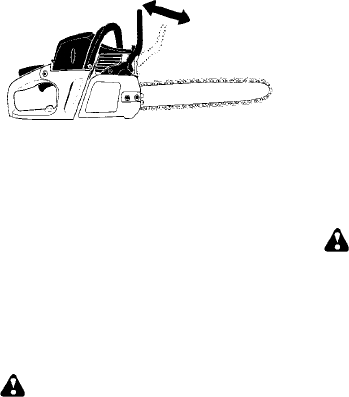
11
S This saw is equipped with a chain b rake.
The brake is designed to stop the chain if
kickback occurs.
S The inertia--activated chain brake is
activated if the front hand guard is pushed
forward, either manually (by hand) or
automatically (by sudden movement).
S If the brake is already activated, it is
disengaged by pulling the front hand guard
back toward the front handle as far as
possible.
S When cutting withthesaw,thechainbrake
must be disengaged.
Engaged
Disengaged
Braking function control
CAUTION:
The chain brake must be
checked several times daily. The engine
must berunning whenperformingthis proce-
dure. This isthe only instancewhen thesaw
should be placed on the ground with th e en-
gine running.
Place the saw on firm ground. Grip the rear
handlewithyourrighthand andthe fronthan-
dle with your left hand. Apply full throttle by
fully depressing the throttle trigger. Activate
the chain brake by turning your left wrist
against the hand guard without releasing
your grip around the front handle. The chain
should stop immediately.
Inertia activating function control
WARNING: When performing the
following procedure, the engine must be
turned off.
Grip the rear handlewith your right handand
the front handle with yourleft hand. Holdthe
chain saw approximately 14″ (35 cm) above
a stump or other wooden surface. Release
your grip on the front handle and use the
weight ofthe sawtolet thetip ofthe guidebar
fallforwardandcontactthestump. Whenthe
tipof thebar hits thestump,the b rakeshould
activate.
OPERATING TIPS
S Check chain tension before first use,after
1 minute of operation, and each time be-
fore you start the chain saw . See CHAIN
TENSION in the ASSEMBLY section.
S Cut wood only. Do not cut metal, plastics,
masonry , non-wood building materi als, e tc.
S Stop the saw if the chain strikes a foreign
object. Inspect the saw and repair or re-
place par ts as necessary. If the chain
jumps off t he guide bar, inspect the chain
fordamaged drive links beforereinstalling.
Burrs on drive links, which prevent them
from entering the groove of t he guide bar,
can be rem oved with a flat file.
S Keep the chain out of dirt and sand. Even a
small amount of dirt will dull a chain, increase
the possibility of kickback, and require chain
sharpening o r replacement.
S Practice cutting a few smalllogs using the
following techniques to get the“feel” of us-
ing your saw before you begin a major
sawing operation.
S Squeeze the throttle trigger and allow the
engine to reach full speed before cutting.
S Begin cutting with the saw frame
against the log.
S Keepthe engine at full speed the entire
time you are cutting.
S Allowthechaintocutforyou. Exertonly
light downward pressure. If you force
thecut,damage tothebar,chain,oren-
gine can result.
S Release the throttle trigger as soon as
the cut is completed, allowing the en-
gine to idle. If you run the saw at full
throttle withouta cutting load,unneces-
sary wear can occur to the chain, bar,
and engine. It is recommended that
the engine not be operated for lon-
ger than 30 seconds at full throttle.
S Toavoidlosingcontrolwhencutiscom-
plete,donotputpressureonsaw atend
of cut.
S Stop the engine before setting the saw
down after cutting.
TREE FELLING TECHNIQUES
WARNING: Check for broken or
dead branches which can fall while cutting
causingserious injury. Do notcutnearbuild-
ings or electricalwires ifyou donot know the
directionof treefall, norcutatnight sinceyou
will not be ale to see well, nor during bad
weather such as rain, snow,or strongwinds,
etc. If the treemakes contact with any utility
line, the utility company should be notified
immediately .
S Carefullyplanyour sawingoperation inad-
vance.
S Cleartheworkarea. You needa cleararea
allaround thetree so you can havesecure
footing.
S The chain saw operat or should keep on
the uphill side of the terrain as the tree is
likely torollor slidedownhill afterit isfelled.
S Study the natural conditions that can cause
the tree to fall in a particular direction.
Natural conditions that can cause a tree to
fall in a particular direction include:
S The wind direction and speed.
S The lean of the tree. The lean of a tree
might not be apparent due to uneven or
sloping terrain. Usea plumbor level tode-
termine the direction of tree lea n.
S Weight and branches on one side.
S Surrounding trees and obstacles.
Look for decay and rot. If thetrunk is rotted,
it can snap and fall toward the operator.
Check for broken or dead branches which
can fall on you while cutting.
Make sure there is enough room for the tree to
fall. Maintain a distance of
2-1/2 tree lengths
from the nearest person or other objects. En-
gine noise can drown out a warning call.
Remove dirt, stones, loose bark, nails, sta-
ples, andwire fromthe treewherecuts areto
be made.


















